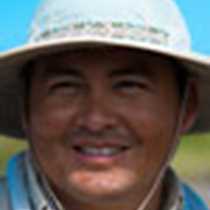Santa Cruz Island
A quiet and overcast day became one of the most successful days in the Galapagos Islands. Today we were visiting the northwestern coast of Santa Cruz Island. This island has an area of 986 square kilometers (381 sq. mi) and a maximum altitude of 864 meters (2,835 ft). Santa Cruz is the second largest island after Isabela and is located in the center of the archipelago. Santa Cruz is a large dormant volcano and it is estimated that the last eruption occurred around a million and a half years ago. Because of its geological formation and location within the archipelago, Santa Cruz is a mosaic of species. Our explorers enjoyed different activities such as hiking, snorkeling, and Zodiac rides throughout the day.
Our first outing took place at Dragon Hill, named after the land iguanas that resemble prehistoric creatures. This place has the remnant population of iguanas that centuries ago populated the entire island. A brackish lagoon formed behind the beach housed flamingoes and migratory birds such as sandpipers, whimbrels, and ruddy turnstones. The exploration continued to a white sand beach where we were able to sight some marine iguanas, striated herons and Sally Lightfoot crabs. The giant cactus, unique to this area, made a great place for finding land iguanas foraging as well as Darwin finches and mockingbirds.
Later in the morning our nature quest continued in the crystal clear water of the tropical Pacific Ocean; our explorers joined us for snorkeling at Guy Fawkes Islets, which are offshore Santa Cruz Island. This place astonished us with the colorful steep walls full of invertebrate life. Besides cup corals, starfish, and anemones, some big species showed up. For example, sea lions, white-tip reef sharks, and Indo-Pacific bonitos “tuna fish” were the attraction in this outing. While we were heading back to our home National Geographic Endeavor, sea turtles and manta rays were courting on the calm ocean. To gain energy for our next adventure, a delightful Ecuadorian buffet was served today.
In the afternoon our expedition continued in another place on the coast of Santa Cruz Island known as Eden. A Zodiac ride along of the rocky coastline and mangrove forest captivated our explorers; the shallow waters of this place made this ride a unique moment when sea turtles, eagle rays, and baby sharks were observed from the Zodiacs. Late in the afternoon as part of our adventure the National Geographic Endeavour took us to Daphne Major, a small island north of Santa Cruz and west of Baltra; while we were heading to this inaccessible island bottlenose dolphins were sighted. The island of Daphne is important as the location of multi-decade finch population studies by Peter and Rosemary Grant. While we were circumnavigating Daphne Island, Blue-footed boobies, nazca boobies, and frigates birds made this afternoon unforgettable.




